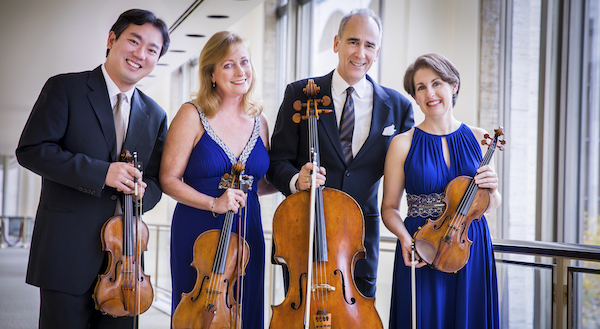New York Philharmonic Quartet wraps season with devastating Shostakovich

The New York Philharmonic String Quartet performed Tuesday night at Temple Beth Am in Pinecrest. Photo: Chris Lee
When four first-chair players from a major American orchestra get together to make chamber music, the change of pace from playing orchestral showpieces can be refreshing and exhilarating for musicians and listeners alike.
That is exactly what occurredTuesday night when the New York Philharmonic String Quartet took the stage at Temple Beth Am in Pinecrest in a concert that concluded season for Friends of Chamber Music.
These players are all first-class artists in their own right. Concertmaster Frank Huang is the former first violin of the Ying Quartet. Before joining the New York ensemble at the behest of the late Kurt Masur, cellist Carter Brey was a much-in-demand, major-league soloist. Sheryl Staples’ is the Philharmonic’s associate concertmaster, and Cynthia Phelps has long been considered one of the best orchestral violists in the country.
The ensemble’s reading of Shostakovich’s Quartet No. 9 in E-flat Major was by turns deeply searching, superbly executed and emotionally overwhelming.
As Brey noted in pre-performance comments, by 1964 (when the quartet was written) Shostakovich’s musical combination of wit and sarcasm had turned to bitterness in the wake of Soviet repression and persecution of artists. Angst of the distinctively Russian variety runs through the five interconnected movements of the Ninth Quartet. Shostakovich’s chamber works are his most intimate and personal testament and this quartet is one of his finest, most subtly crafted scores.
The tonally ambiguous opening immediately casts an aura of darkness. Over pizzicatos from the other three players, the cello introduces a terse motif that is repeated by the viola and then taken up by the first violin in harmonics. The players took a slower, more measured approach to the spare lines, generating greater cumulative force. Phelps spun the searing principal theme of the second movement Adagio in long, spacious paragraphs in a rich, darkly colored sonority.
An Allegretto recalls the scherzos of Shostakovich’s symphonies but the false high spirits quickly run off the rails. The players’ precision and realization of controlled chaos was devastating in its sheer power.
Abrupt plucked chords interrupt the elegiac fragments of the Adagio, one of Shostakovich’s deepest expressions of despair. Huang’s intensity of expression and tonal gleam brought out the agony beneath Shostakovich’s extended solos. The driving bitter energy of the final Allegro was assayed at top speed with dazzling virtuosity. Brey strummed the strings of his cello as prelude to the return of the quartet’s spare opening thematic strands. One could hardly imagine this score played with greater technical security or plumbing more vivid revelation beneath the notes.
If the Shostakovich performance was the concert’s high point, the Haydn and Brahms quartets surrounding it were hardly given short thrift.
Haydn’s Quartet in D minor, Op. 76, no. 2 was articulated with crisp bravura. Each of the variations in the Andante was given character and specificity of utterance. There was a touch of Magyar paprika in the trio of the minuet, with the undercurrent of Phelps’ viola and Brey’s cello strongly projected. Both the high spirits and mock stormy interjections of the finale were fully encapsulated.
The gentle warmth of Brahms’ Quartet No. 2 in A minor, the program’s concluding offering, was the perfect antidote to the ecstasy-less agony of the Shostakovich quartet.
Avoiding the temptations of extreme speed or over-deliberate tempos, the players conveyed the Brahmsian melancholy of the initial Allegro non troppo with a sense of natural flow and pulse. Played in a straightforward, no-nonsense manner, the contrasting lightness of the Viennese melodies was all the more effective.
Brahms’ sentimental version of a minuet in the third movement was given spacious treatment. With Huang and Staples’ violins in fiery mode, a hard-charging version of the concluding czardas was almost orchestral in clarity of individual texture and supple variety of dynamics.
Happily, the New York Philharmonic Quartet will return next season (with pianist Joseph Kalichstein).
Friends of Chamber Music’s 2019-2020 season opens October 24 with violinist Christian Tetzlaff and pianist Lars Vogt. miamichambermusic.org
Posted in Performances
Leave a Comment
Wed May 15, 2019
at 12:47 pm
No Comments






